|
Me Sahyadri |
|
Best of Me Sahyadri |
|
December 2015 |
|
Volume 2, number 12 |
Please use minimum 1280 pixel horizontal screen
resolution for viewing. Please be patient while all the images in
webpage are loaded. Please do not use the images for any commercial
use without permission. Text in Marathi and English is not exact
translation. Please give sufficient time to allow the photographs to load. Special thanks to Mr. Balasaheb Yelwande, Mr. Amey Joshi, Mr. Adhesh Shivkar, Mr. Mandar Khadilkar for very good help while making images, and to all those who helped me during the compilation and field work for the help and guidance. |
|
|
|
|
|
|
सह्याद्री (पश्चिम घाट) हा एक नैसर्गिक संपदेचा, वैविध्यतेचा, भौगोलिक व ऐतिहासिक ठेवा आहे. वाढत्या मानवी अतिक्रमणाचा, सह्याद्रीच्या विविध घटकांवर होणारा दुष्परिणाम भविष्यात आपल्यालाच धोका निर्माण करेल, यात शंका नाही. शुद्ध पाणी, हवा व उर्जा, भावी पिढीला मिळण्यासाठी, नंद्यांचे उगम असलेला सह्याद्री व त्याभागातील जंगले टिकवणे महत्वाचे आहे. सह्याद्रीच्या महत्वाच्या घटकांचे महत्व छायाचित्रांद्वारे प्रकट करण्याचा मी येथे प्रयत्न केला आहे. येथील पक्षी, प्राणी, वनस्पती, अधिवास, किल्ले व लेणी अशा विविध विषयांबद्दल आपण समजुन घेऊ.
|
|
Western ghats, or Sahyadri as we all call it as, is a treasure trove of spectacular landscapes, biodiversity, flora, fauna, some amazing geological wonders and manmade monuments. With the increasing pressure from human encroachment, all these elements are under stress and in turn are under depletion. Western ghats should be left untouched by human beings, to protect their future generations from getting short of resources, such as water, energy and clean air. The important elements of western ghats, which need protection are highlighted in the new version of Photo journal , Me Sahyadri Magazine. The various issues of journal have a brief of inspiring subjects such as birds, mammals, forts, ancient caves, snakes and the ambiance.
|
|
|
| |
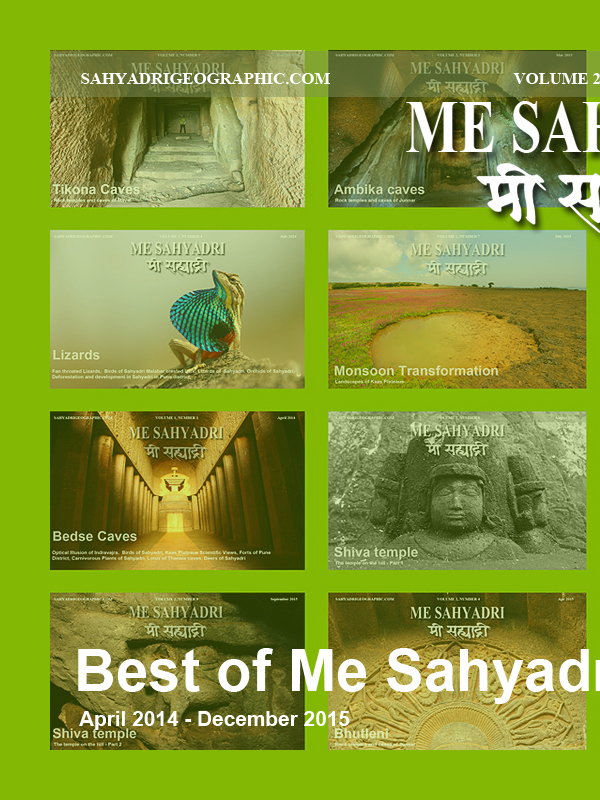 
|
| |
Me Sahyadri - December 2015
Best of Me Sahyadri
Visit the Photoessay published in December 2015, by clicking on the image.
|
| |
|
|
या पानावर "मी सह्याद्री" ची सर्व मुखपृष्ट संकलीत केली आहेत.
|
|
On this page all the covers of Me Sahyadri are listed.
|
|
|
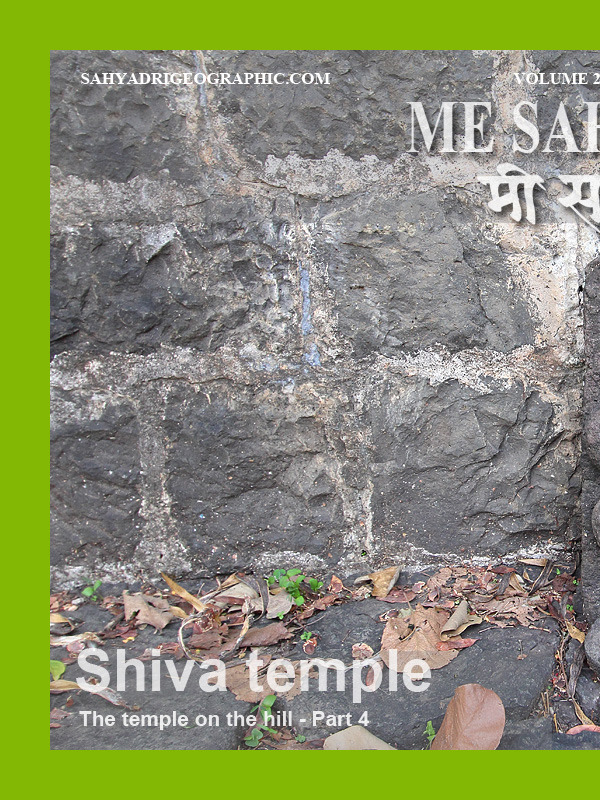 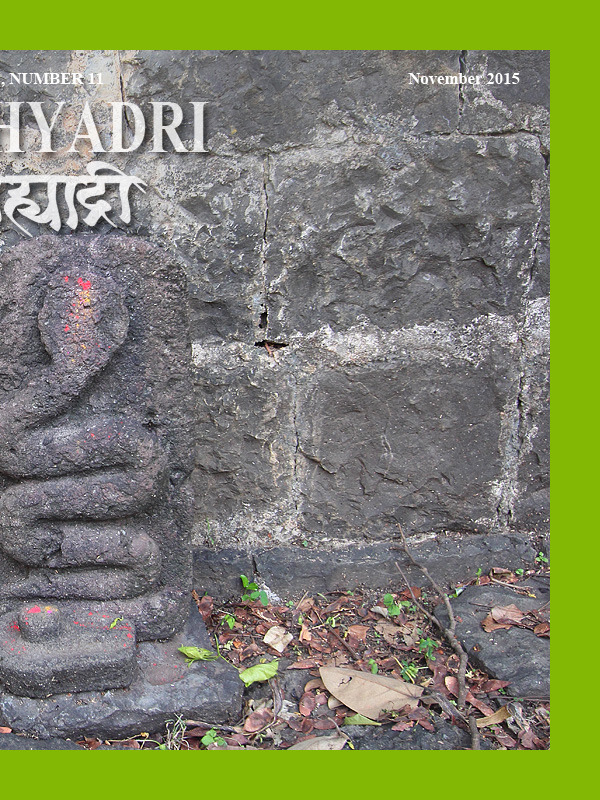
|
| |
Me Sahyadri - November 2015
Pateshwar Shiva Temple Part 4, western ghat,India
Visit the Photoessay published in November 2015, by clicking on the image.
|
| |
|
|
पाटेश्वर/पाठेश्वर मंदिर समुह साताऱ्याच्या पुर्वेस डोंगरावर आहे. या समुहात प्रामुख्याने, माथ्यावरचे मुख्य देऊळ, पुर्वेकडचे वऱ्हाडाचे देऊळ आणी या दोन्ही मध्ये असलेला लेणी समुह हे तीन भाग आहेत. डोंगराच्या माथ्यावर असलेल्या या सुंदर मंदिरसमुहाचे वैशिष्ट्य येथील असंख्य शिव पिंडी, आणी येथील शांतता आहे. या चित्रनिबंधात मुख्य मंदिरांबद्दल माहिती व प्रकाशचित्रे मांडली आहेत. संपुर्ण मंदिरावर आधारीत असलेल्या चार चित्रनिबंधातील हा चौथा चित्रनिबंध आहे.
|
|
Pateshwar or Patheshwar is a small temple complex located on a hill near Satara, Maharashtra. The temple complex consists of three zones. The old Shiva temple complex, rock cut caves and temples around caves and the main Shiva temple. Located high on the hill the most magnificence of the place is in the tranquility here with many interesting shiva linga and the other sculptures. This photoessay covers only a part of the complex. The entire temple complex is covered in four separate photoessays. This is the fourth photoessay of the series and covers the main temple of Pateshwar.
|
|
|
| |
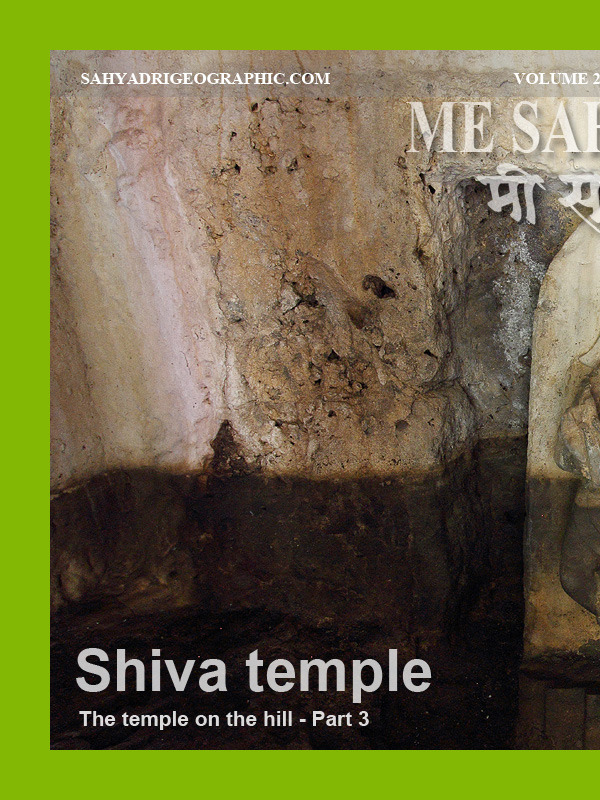 
|
| |
Me Sahyadri - October 2015
Pateshwar Shiva Temple Part 3, western ghat,India
Visit the Photoessay published in October 2015, by clicking on the image.
|
| |
|
|
पाटेश्वर/पाठेश्वर मंदिर समुह साताऱ्याच्या पुर्वेस डोंगरावर आहे. या समुहात प्रामुख्याने, माथ्यावरचे मुख्य देऊळ, पुर्वेकडचे वऱ्हाडाचे देऊळ आणी या दोन्ही मध्ये असलेला लेणी समुह हे तीन भाग आहेत. डोंगराच्या माथ्यावर असलेल्या या सुंदर मंदिरसमुहाचे वैशिष्ट्य येथील असंख्य शिव पिंडी, आणी येथील शांतता आहे. या चित्रनिबंधात दोन मुख्य मंदिरांच्या दरम्यान असलेल्या लेणीसमुहाबद्दल व लहान मंदिरांबद्दल माहिती व प्रकाशचित्रे मांडली आहेत. संपुर्ण मंदिरावर आधारीत असलेल्या चार चित्रनिबंधातील हा तिसरा चित्रनिबंध आहे.
|
|
Pateshwar or Patheshwar is a small temple complex located on a hill near Satara, Maharashtra. The temple complex consists of three zones. The old Shiva temple complex, rock cut caves and temples around caves and the main Shiva temple. Located high on the hill the most magnificence of the place is in the tranquility here with many interesting shiva linga and the other sculptures. This photoessay covers only a part of the complex. The entire temple complex will be covered in four separate photoessays. This is the third photoessay of the series and covers the cave complex between two main temples of Pateshwar and surrounding small temples around these caves.
|
|
|
| |
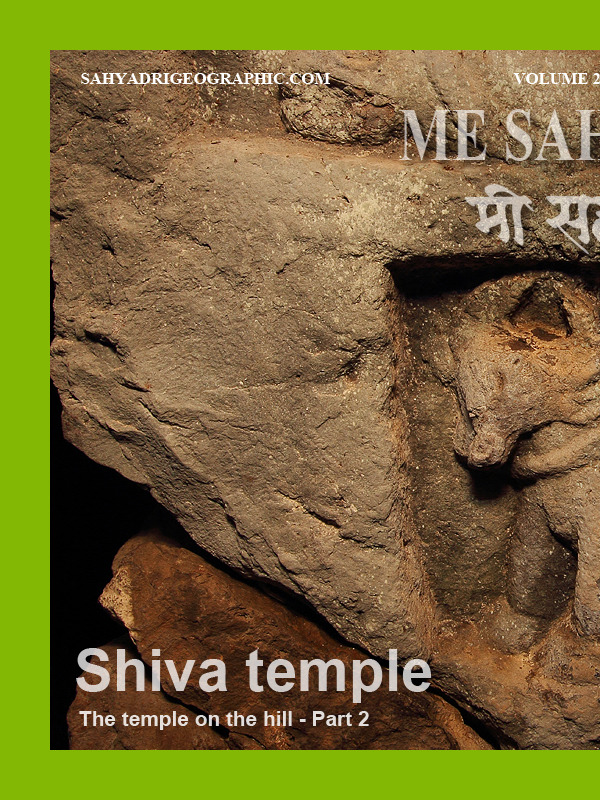 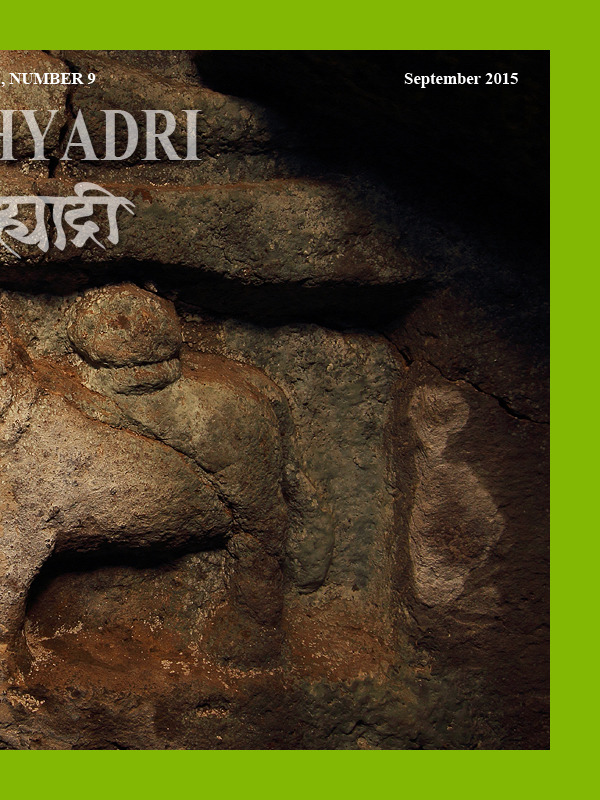
|
| |
Me Sahyadri - September 2015
Pateshwar Shiva Temple Part 2, western ghat,India
Visit the Photoessay published in September 2015, by clicking on the image.
|
| |
|
|
पाटेश्वर/पाठेश्वर मंदिर समुह साताऱ्याच्या पुर्वेस डोंगरावर आहे. या समुहात प्रामुख्याने, माथ्यावरचे मुख्य देऊळ, पुर्वेकडचे वऱ्हाडाचे देऊळ आणी या दोन्ही मध्ये असलेला लेणी समुह हे तीन भाग आहेत. डोंगराच्या माथ्यावर असलेल्या या सुंदर मंदिरसमुहाचे वैशिष्ट्य येथील असंख्य शिव पिंडी, आणी येथील शांतता आहे. मागील चित्रनिबंधात वऱ्हाडाच्या मंदिरातील मुख्य दालनाबद्दल माहिती व प्रकाशचित्रे मांडली आहेत.
या चित्रनिबंधात वऱ्हाडाच्या मंदिरातील इतर दालनांबद्दल माहिती व प्रकाशचित्रे मांडली आहेत. संपुर्ण मंदिरावर आधारीत असलेल्या चार चित्रनिबंधातील हा दुसरा चित्रनिबंध आहे.
|
|
Pateshwar or Patheshwar is a small temple complex located on a hill near Satara, Maharashtra. The temple complex consists of three zones. The old Shiva temple complex, rock cut caves and temples around caves and the main Shiva temple. Located high on the hill the most magnificence of the place is in the tranquility here with many interesting shiva linga and the other sculptures. The previous photoessay in last month covered the main chamber of the old shiva temple complex. This photoessay covers remaining part of the old shiva temple complex. The entire temple complex will be covered in four separate photoessays. This is the second photoessay of the series.
|
|
|
| |
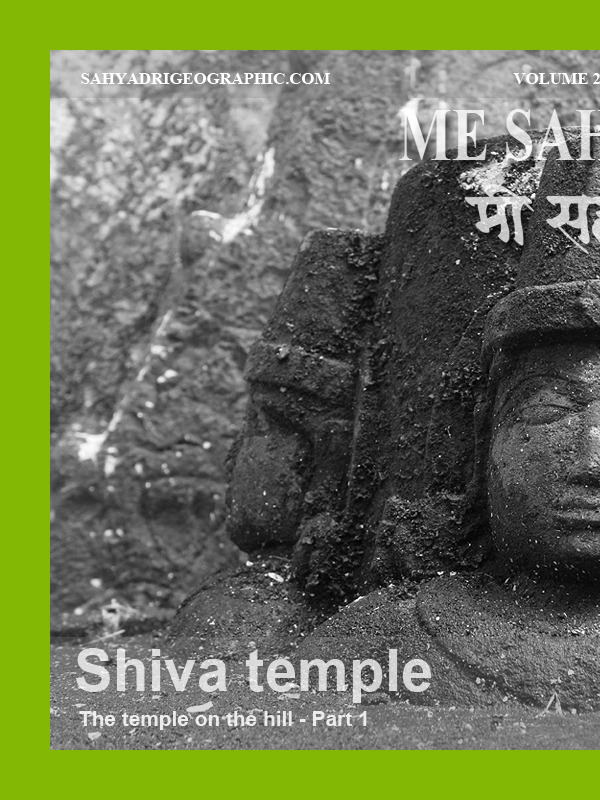 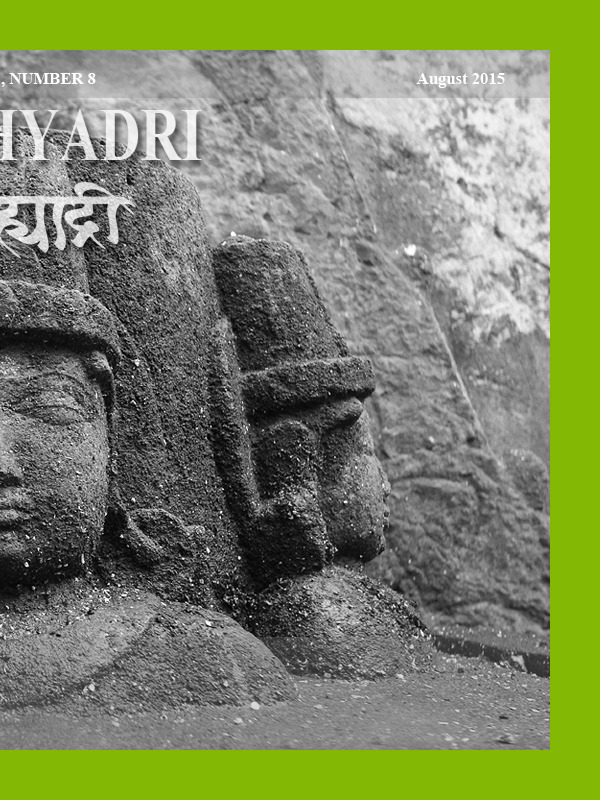
|
| |
Me Sahyadri - August 2015
Pateshwar Shiva Temple Part 1, western ghat,India
Visit the Photoessay published in August 2015, by clicking on the image.
|
| |
|
|
पाटेश्वर/पाठेश्वर मंदिर समुह साताऱ्याच्या पुर्वेस डोंगरावर आहे. या समुहात प्रामुख्याने, माथ्यावरचे मुख्य देऊळ, पुर्वेकडचे वऱ्हाडाचे देऊळ आणी या दोन्ही मध्ये असलेला लेणी समुह हे तीन भाग आहेत. डोंगराच्या माथ्यावर असलेल्या या सुंदर मंदिरसमुहाचे वैशिष्ट्य येथील असंख्य शिव पिंडी, आणी येथील शांतता आहे. या चित्रनिबंधात वऱ्हाडाच्या मंदिरातील मुख्य दालनाबद्दल माहिती व प्रकाशचित्रे मांडली आहेत. संपुर्ण मंदिरावर आधारीत असलेल्या चार चित्रनिबंधातील हा प्रथम चित्रनिबंध आहे.
|
|
Pateshwar or Patheshwar is a small temple complex located on a hill near Satara, Maharashtra. The temple complex consists of three zones. The old Shiva temple complex, rock cut caves and temples around caves and the main Shiva temple. Located high on the hill the most magnificence of the place is in the tranquility here with many interesting shiva linga and the other sculptures. This photoessay covers only a part of the old shiva complex. The entire temple complex will be covered in four separate photoessays. This is the first photoessay of the series.
|
|
|
| |
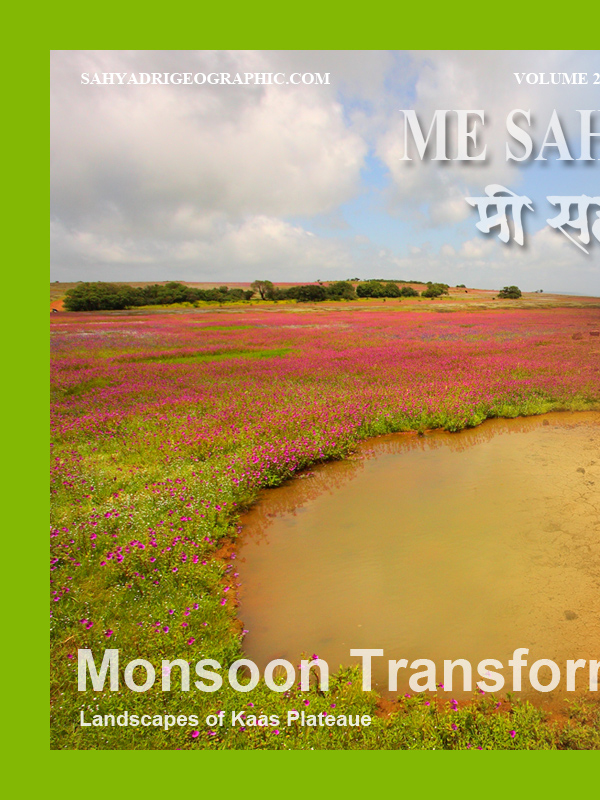 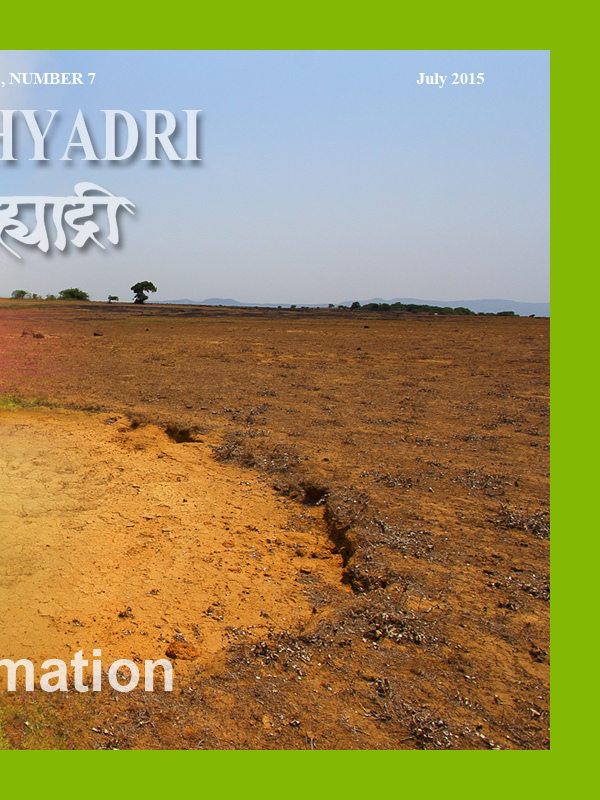
|
| |
Me Sahyadri - July 2015
Monsoon Transformation of Kaas Plateau, western ghat,India
Visit the Photoessay published in July 2015, by clicking on the image.
|
| |
|
|
सह्याद्रीच्या डोंगररांगेत, सातारा जिल्ह्याच्या दक्षिणेकडे, सपाट माथा असलेले डोंगर दिसतात. या डोंगरांच्या माथ्यावर सड़्याचे पठार आहेत. सच्छिद्र जांभा अग्निजन्य दगड येथे पहावयास मिळतो. दुरुन पाहिल्यास हे डोंगरमाथे कृत्रिमरित्या सपाट केल्यासारखे वाटतात, मात्र ते नैसर्गिकरित्या सपाट आहेत. रायरेश्वर, कास, पाचगणी, कमळगड इत्यादी ठिकाणी असे सड़्याचे डोंगर आहेत. पावसाळ्यात कास ला भरपुर पाऊस पडतो. (२००० ते २५०० मिलीमीटर). जांभा दगड सछिद्र असल्याने येथे पावसाच्या पाण्याचा निचरा होतो. पठाराच्या काही भागात असलेल्या पातळ मातीच्या थरावर लहान व सुक्ष्म वनस्पती वाढतात. येथे बऱ्याच वनस्पती दुर्मिळ, कमी जीवनसत्वावर जगणाऱ्या आहेत. या वनस्पतींचे रहाणीमान इतरत्र आढळणाया वनस्पतींपेक्षा विलक्षण वेगळे व दुर्मिळ आहे. अशा विविध वनस्पतींचा व किटकांचा येथे आगळावेगळा समाज तयार झाला आहे. उन्हाळ्यात रुक्ष दिसणाऱ्या पण पावसाळ्यात बहरणाऱ्या या अदभुत सृष्टीला जपणे हे आपले कर्तव्य आहे.
|
|
Western Ghats south of Maharashtra have many flat table top mountains, with lateritic plateaus at the top. When viewed from distance the hills look so flat as if they were done so artificially. Lateritic plateau of Kaas is one of such many plateaus in the region. The volcanic rock at the top has been eroded over the years due to heavy rains of monsoon. The soft portions of the rock are eroded leaving behind the porous rock with hard elements. The thin layer of sandy soil over such rock does not have much nutrition. Due to this reason, at Kaas, the soil has many unique wildflower plants, herbs blooming in Monsoon, some of them being insectivorous plants. Though many herbs are very tiny, this plateau and the region around get dramatically transformed in the monsoon and in post monsoon season. The area is very scenic with beautiful vistas, and requires special protection for its flora, fauna and landscapes.
|
|
|
| |
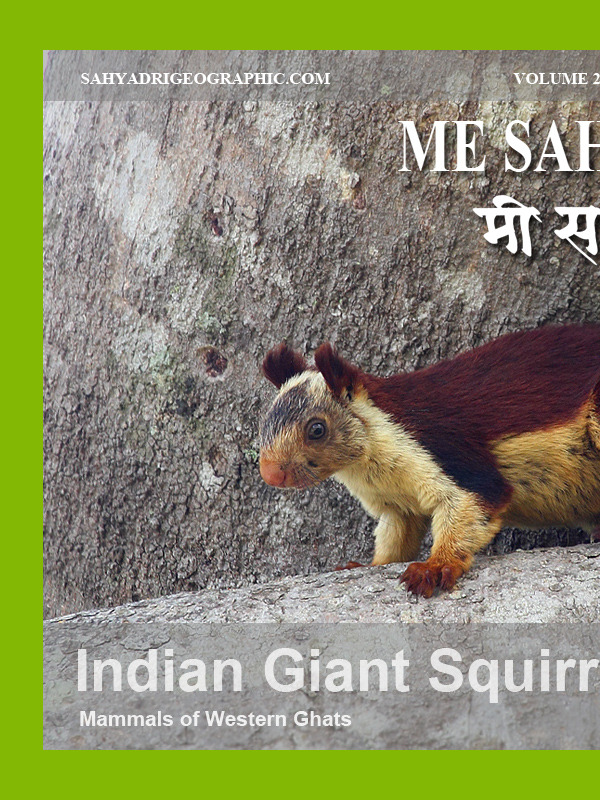 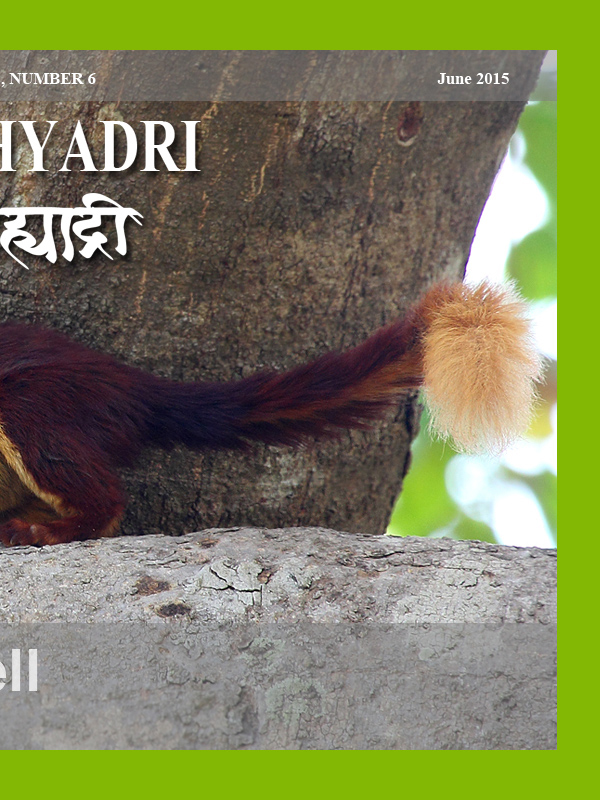
|
| |
Me Sahyadri - June 2015
Malabar giant squirrel, western ghat,India
Visit the Photoessay published in June 2015, by clicking on the image.
|
| |
|
|
या सदरात, सह्याद्रीच्या विविध घटकांबद्दल छायाचित्र व माहिती द्वारे तोंडओळख मांडली आहे. या चित्रनिबंधात महाराष्ट्राचा राज्यप्राणी शेकरु बद्दल छायाचित्रे व मजकुर आहे.
भारतात विविध खारींच्या जाती आहेत. यामध्ये आपल्याला नेहेमी दिसणारी लहान खार सर्वांना ओळखीची आहे. पाठीवर तीन पट्टे असलेली खार दक्षिण भारतात व पाठीवर पाच पट्टे असलेली लहान खार उत्तर भारतात दिसते. या लहान खारींची संपुर्ण लांबी (डोके ते शेपटाचे टोक) अंदाजे २६ ते ३० से.मी. असते.
या लहान खारींपेक्षा आकाराने खुप मोठया खारी, भारतीय़ जंगलांमध्ये आढळतात. मोठया खारींच्या जातींपैकी एक आहे, "इंडियन जायन्ट स्क्विरेल". या खारीला "मलबार जायन्ट स्क्विरेल", असे सुद्धा संबोधतात. महाराष्ट्रात या जायन्ट खारीला शेकरु असे नाव आहे. तामिळनाडु मध्ये शेकरु "अनिल", व केरळ मध्ये "मलायन" म्हणुन ओळखले जाते.
शेकरुची डोक्यापासुन शेपटाच्या टोकापर्यंत एकुण लांबी ९० ते ११० से.मी असते. शेपटाव्यतिरिक्त लांबी ३५ ते ५० से.मी असते. साध्या लहान खारीपेक्षा शेकरु ३-४ पट लांब असते. शेकरुचे वजन लहान खारीच्या वजनापेक्षा १५-२० पट असते. शेकरुचे वजन अंदाजे २ किलो असते. आपण नेहेमी पहातो त्या लहान खारीच्या पेक्षा आकाराने मोठया या शेकरुला म्हणुनच जायन्ट स्क्विरेल, महाखार असे म्हणतात.
|
|
This journal introduces you to one of the arboreal mammal of western ghats, "Indian Giant Squirrel" using brief information and photographs.
In India, we are used to see the common squirrel in and around urban as well as rural human habitations. The common three striped palm squirrel seen in south India is about 120-150 mm long (head to body length) and its tail is about 140-160 mm long. Similarly the northern or five striped palm squirrel is 130-160 mm long (Head to body length) and its tail is about 140-160 mm long. So the total head to tail length of common palm squirrels is about 26 to 30 cm.
The size of the Indian giant squirrel is about 350 to 510 mm long (head to body), and its tail is further 600 mm long. So total length can be as large as 110 cm. So the Indian giant squirrel is about 3 to 4 times longer than the common palm squirrel. By weight the giant squirrel is about 15-20 times heavier than the palm squirrel. Hence due to its large size it is called as giant squirrel.
|
|
|
| |
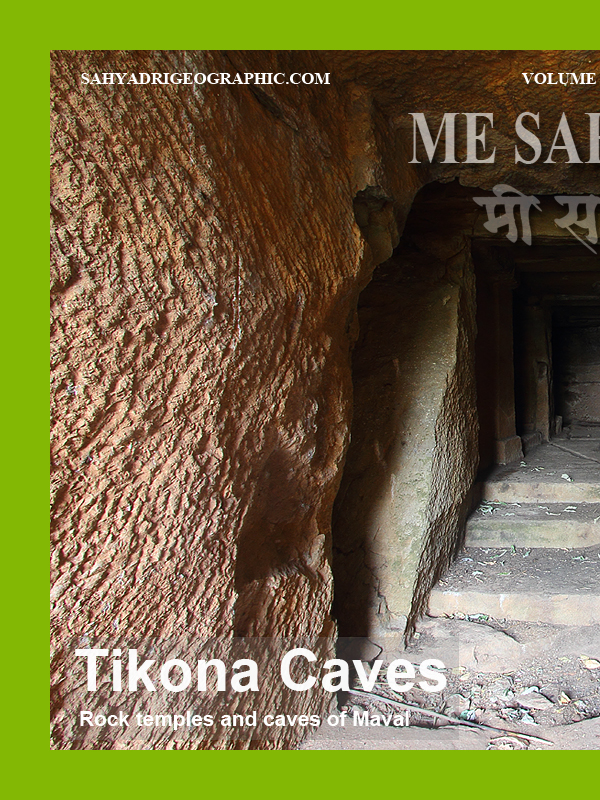 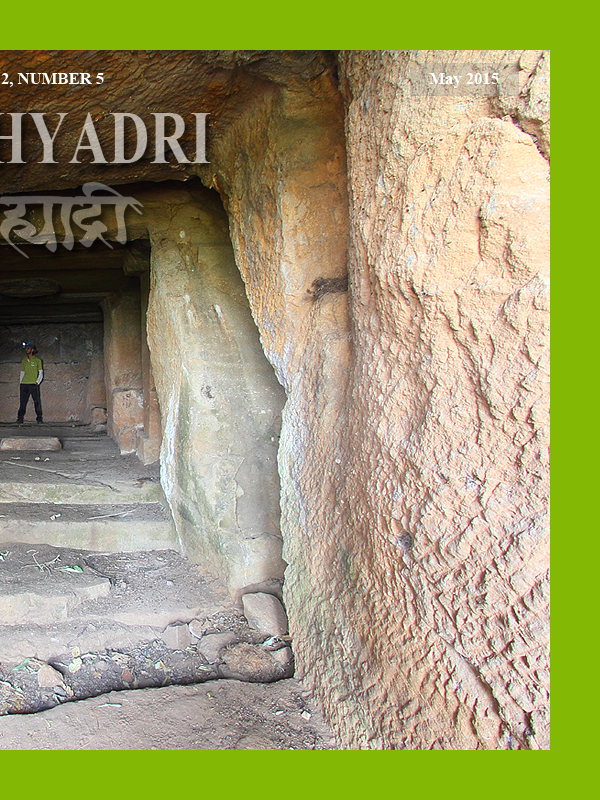
|
| |
Me Sahyadri - May 2015
Tuikona caves, Pune district, western ghat,India
Visit the Photoessay published in May 2015, by clicking on the image.
|
| |
|
|
पुण्याजवळ पवन मावळात, तिकोणा (वितंडगड) किल्ला आहे. डोंगराच्या आकारामुळे याला तिकोणा असे म्हणतात. याचा आकार पिरॅमिड सारखा आहे. गडावर एक लेण्यांचा समुह आहे. याच गडाच्या मागच्या बाजुस काशिग गावाच्या बाजुस अजुन एक लेण्यांचा समुह आहे. बरेच वर्षे मातीखाली दडलेल्या लेण्यांचे उत्खनन गेल्या काही वर्षांमध्ये केलेले आहे.
श्री शिवदुर्ग संवर्धन व स्थानिक गावकऱ्यांनी मिळुन तिकोना किल्यावरच्या या लेण्यांचे उत्खनन केलेले आहे. गावातले दोन स्थानिक युवक गडावर देखरेख करतात. पर्यटकांना मार्गदर्शन, स्वच्छता हे या उपक्रमाचे स्तुत्य उद्देश आहेत.
|
|
In Pune district, in Pawana Maval region, there is a fort known as Tikona. The fort is also known as Vitandgad. The mountain is pyramid shaped and hence the fort is called as Tikona. On the top of the mountain in the fort there is a small group of rock cut caves. In the same mountain, on the back side towards Kashig village at the lower level, there is another cave. These caves at the lower level have been recently excavated and cleaned. The sri Shivdurg Samvardhan NGO from Pune have done the excavation and trail work to reach these caves with the help of local villagers. Interestingly the fort is looked after by two village youth, under the guidance of village committee and NGO. This has helped in maintenance of the fort cleanliness, and guidance to the visitors and tourists.
|
|
|
| |
 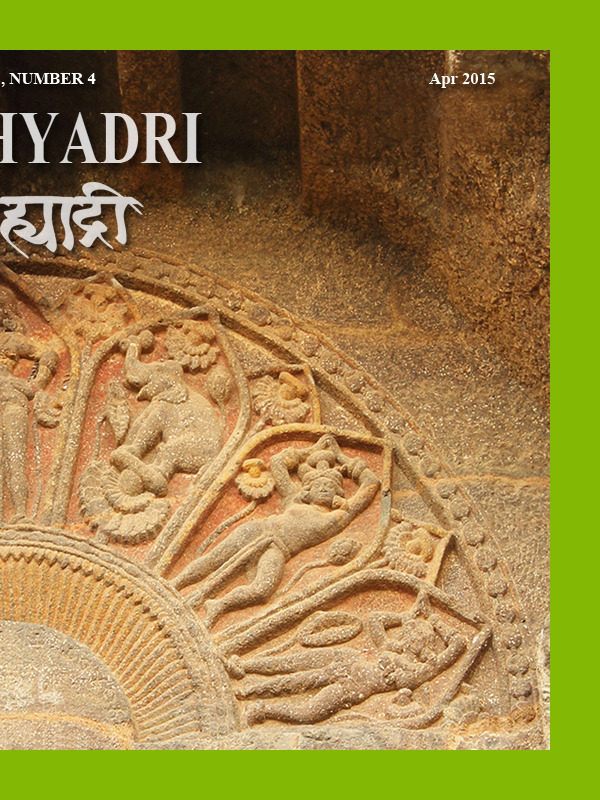
|
| |
Me Sahyadri - April 2015
Bhutling caves, Pune district, western ghat,India
Visit the Photoessay published in April 2015, by clicking on the image.
|
| |
|
|
या सदरात, सह्याद्रीच्या विविध घटकांबद्दल छायाचित्र व माहिती द्वारे तोंडओळख मांडली आहे. खालिल चित्रनिबंधात जुन्नर जवळच्या अंबिका लेण्याबद्दल छायाचित्रे व मजकुर आहे. या लेण्यात माणसांचा वावर तुरळक आहे. येथे मधमाश्यांची पोळी आहेत. अशा ठिकाणी जाण्यापुर्वी मधमाश्यांपासुन कसा बचाव करायचा व प्राथमिक उपचार (फ़र्स्ट एड) बद्दल माहिती करुन घ्यावी. जुन्नरच्या दक्षिणेस अंदाजे १.५ कि.मी. अंतरावर, मानमोडी डोंगरावर ३ ठिकाणी लेणी समुह आहेत. या लेणी समुहांची नावे भुतलिंग लेणी, अंबा अंबिका लेणी आणी भीमाशंकर लेणी अशी आहेत. भुतलिंग लेणी जरी अर्धवट कोरलेली असली तरी याच्या बाह्य भागावर अप्रतिम तोरण कोरलेले आहे.
|
|
This journal introduces you to one of the Buddhist rock temple through brief information and photographs. As the location is unsafe due to habitat of honeybees, please do not venture to the location without professional approach, and local support. Some rock cut caves west of Junaar are located in Maanmodi hill about 1.5 km south from Junnar. There are three groups of caves in Maanmodi hills, viz Bhut leni, Ambika and Bhimashankar.Bhut leni and Ambika caves are facing north, Bhimashankar caves are facing east. The cave is called as Bhutling caves. It has beautiful Torana on its facade.
|
|
|
| |
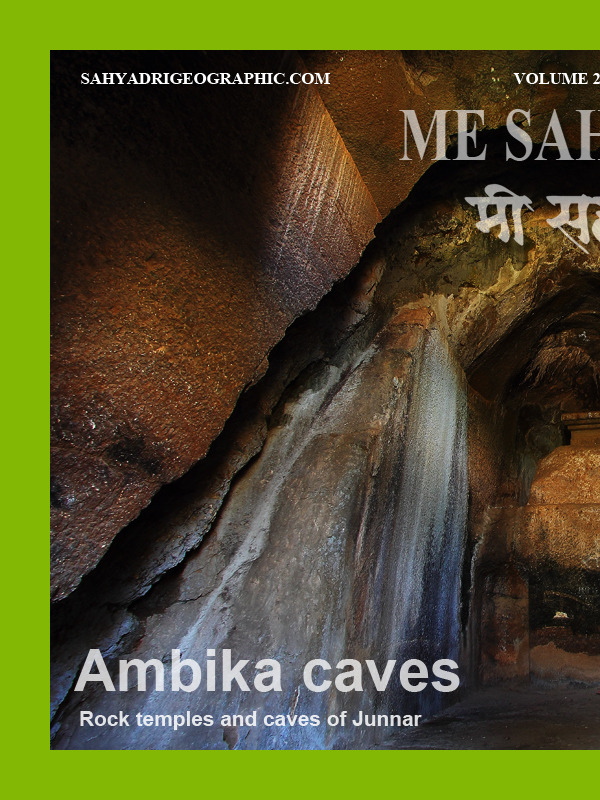 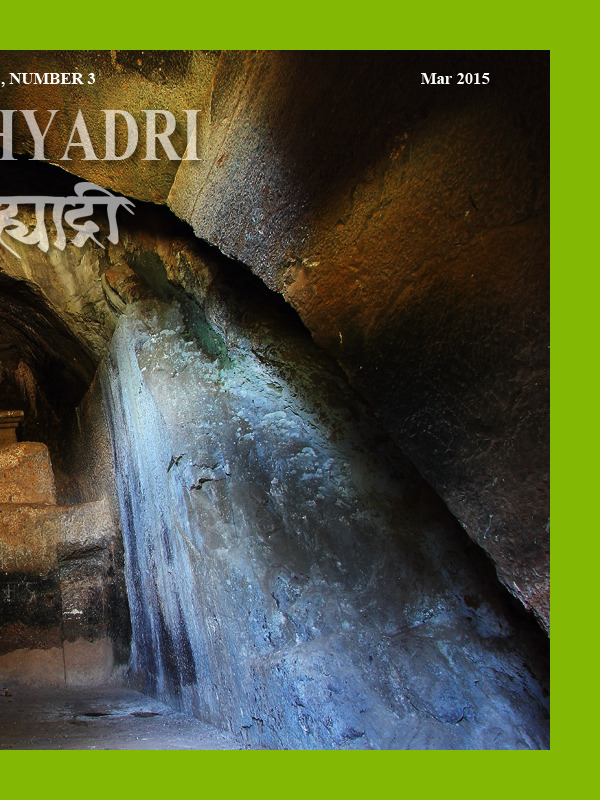
|
| |
Me Sahyadri - March 2015
Ambika caves, Pune district, western ghat,India
Visit the Photoessay published in March 2015, by clicking on the image.
|
| |
|
|
या सदरात, सह्याद्रीच्या विविध घटकांबद्दल छायाचित्र व माहिती द्वारे तोंडओळख मांडली आहे. खालिल चित्रनिबंधात जुन्नर जवळच्या अंबिका लेण्याबद्दल छायाचित्रे व मजकुर आहे. या लेण्यात माणसांचा वावर तुरळक आहे. येथे मधमाश्यांची पोळी आहेत. अशा ठिकाणी जाण्यापुर्वी मधमाश्यांपासुन कसा बचाव करायचा व प्राथमिक उपचार (फ़र्स्ट एड) बद्दल माहिती करुन घ्यावी. जुन्नरच्या दक्षिणेस अंदाजे १.५ कि.मी. अंतरावर, मानमोडी डोंगरावर ३ ठिकाणी लेणी समुह आहेत. या लेणी समुहांची नावे भुतलिंग लेणी, अंबा अंबिका लेणी आणी भीमाशंकर लेणी अशी आहेत. अंबा अंबिका लेणी उत्तरमुखी असुन येथे असलेल्या अंबिका देवीच्या शिल्पामुळे या लेण्याला अंबा अंबिका लेणी असे संबोधतात.
|
|
This journal introduces you to one of the Buddhist rock temple through brief information and photographs. As the location is unsafe due to habitat of honeybees, please do not venture to the location without professional approach, and local support. Some rock cut caves west of Junaar are located in Maanmodi hill about 1.5 km south from Junnar. There are three groups of caves in Maanmodi hills, viz Bhut leni, Ambika and Bhimashankar.Bhut leni and Ambika caves are facing north, Bhimashankar caves are facing east. The cave is called as Ambika caves because there is a Ambika deity shrine in one of the caves.
|
|
|
| |
 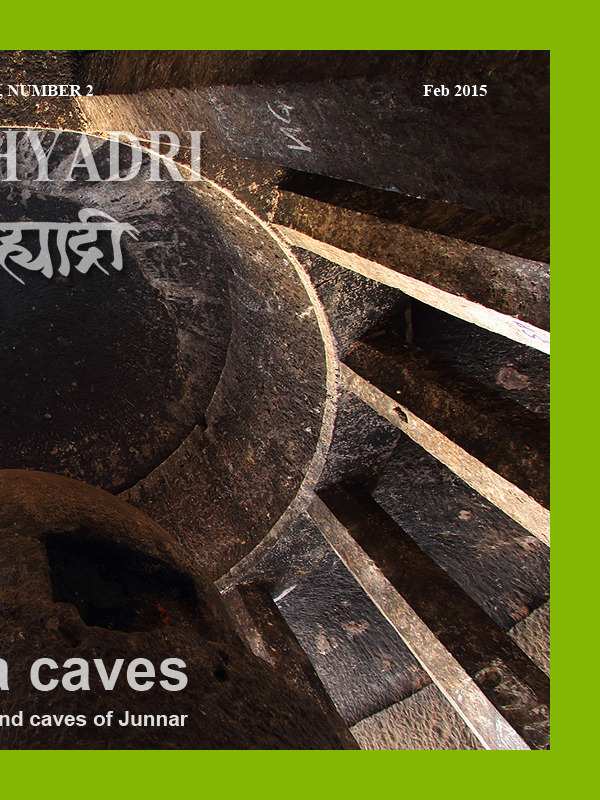
|
| |
Me Sahyadri - February 2015
Tulajaa caves, Pune district, western ghat,India
Visit the Photoessay published in February 2015, by clicking on the image.
|
| |
|
|
जुन्नर शहराच्या पश्चिमेस शिवनेरी पलिकडे अंदाजे २.५ कि. मी. अंतरावर तुळजा लेणी डोंगरावर कोरलेल्या आहेत. लेणी ईशान्यमुखी असुन येथुन त्या दिशेस लेण्याद्रीचा गणॆश डोंगर कुकडी खोऱ्या पलिकडे दिसतो. लेण्यात असलेल्या तुळजा देवीच्या देवळामुळे याला तुळजा लेणी म्हणतात.
|
|
Some rock cut caves west of Junaar are located in spur of Tulajaa hill about 2.5 km from Junnar. The caves are facing north east, and one can see a beautiful view of Lenyadri Ganesh hills at the distance from here beyond the Kukadi river basin. The cave is called as Tulaja caves because there is a modern Tulajaa deity shrine in one of the caves.
|
|
|
| |
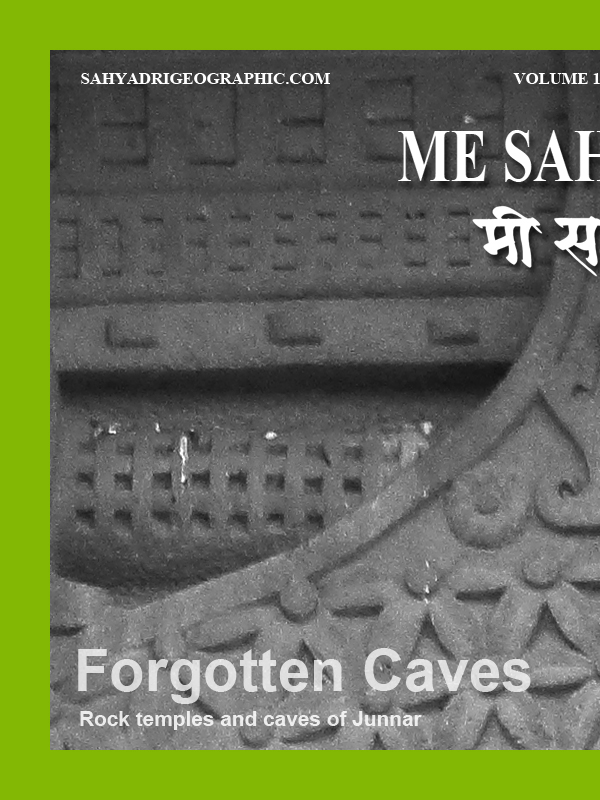 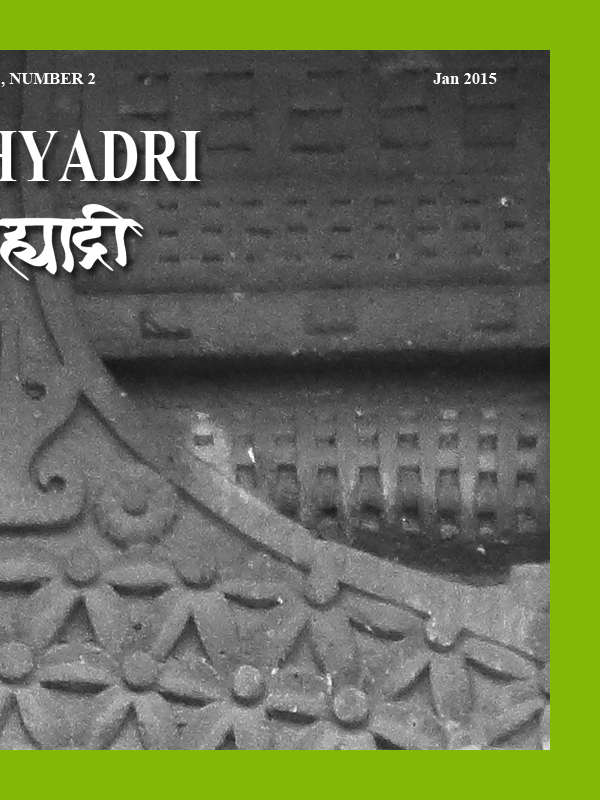
|
| |
Me Sahyadri - January 2015
Suleman caves, Pune district, western ghat,India
Visit the Photoessay published in January 2015, by clicking on the image.
|
| |
|
|
जुन्न्नरच्या भोवताली डोंगर आहेत. या डोंगरात प्राचिन बुद्ध हिनायन लेणी आहेत. अंदाजे ५७ विविध ठिकाणी असलेल्या लेण्यांमध्ये महत्वाचे चैत्यगृह आहेत, विहार आहेत. या लेण्यांचा संबंध बुद्ध, हिंदु व जैन धर्मांशी आहे.या लेण्यांमध्ये प्राचिन सुलेमान लेणी आहे. यालेण्याचा दर्शनी भागावर सुंदर नक्षीकाम आहे.
|
|
Junnar is located on the deccan plateau, 20 km east of the main western ghat ridge. The town is surrounded by hills from all the sides. There are mountain forts and old rock cut caves all around the Junnar town. One of these many caves is Suleman caves . The cave has beautiful ornamental facade.
|
|
|
| |
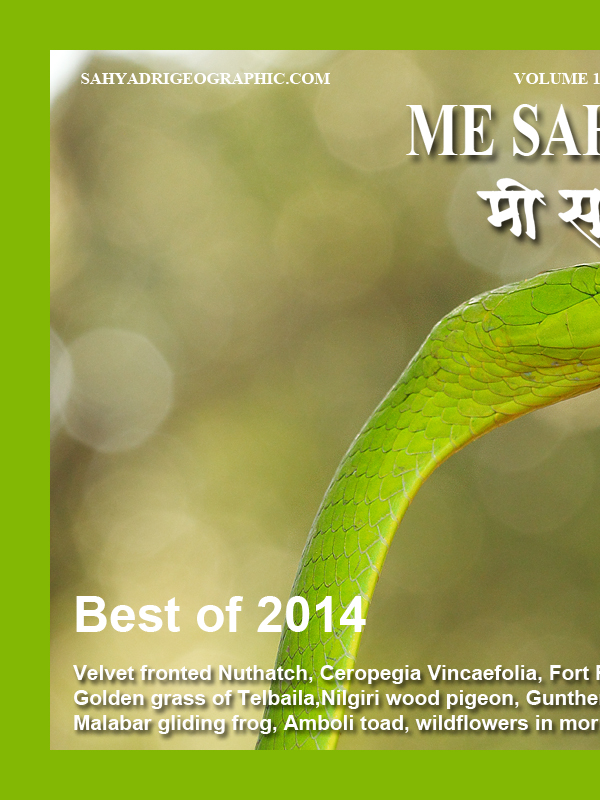 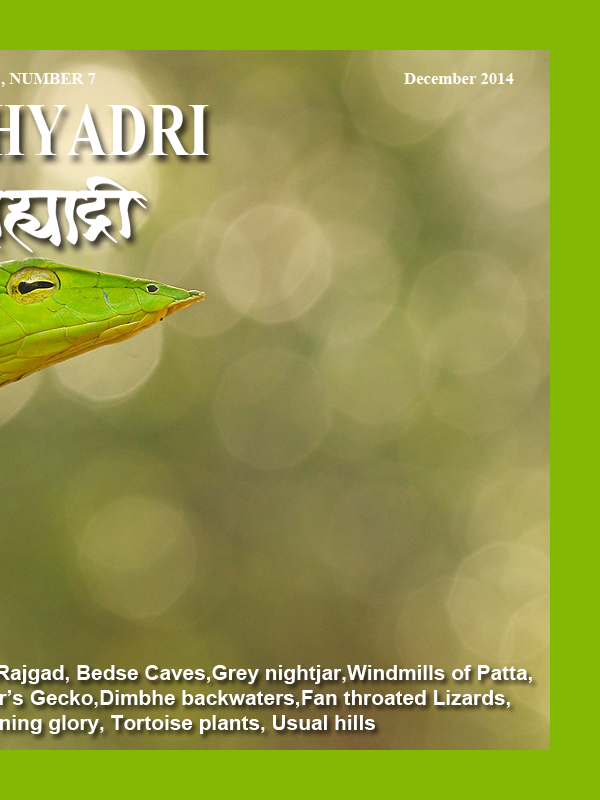
|
| |
Me Sahyadri - December 2014
Best of 2014
Visit the Photoessay published in December 2014, by clicking on the image.
|
| |
|
|
सह्याद्री (पश्चिम घाट) हा एक नैसर्गिक संपदेचा, वैविध्यतेचा, भौगोलिक व ऐतिहासिक ठेवा आहे. वाढत्या मानवी अतिक्रमणाचा, सह्याद्रीच्या विविध घटकांवर होणारा दुष्परिणाम भविष्यात आपल्यालाच धोका निर्माण करेल, यात शंका नाही. शुद्ध पाणी, हवा व उर्जा, भावी पिढीला मिळण्यासाठी, नंद्यांचे उगम असलेला सह्याद्री व त्याभागातील जंगले टिकवणे महत्वाचे आहे. सह्याद्रीच्या महत्वाच्या घटकांचे महत्व छायाचित्रांद्वारे प्रकट करण्याचा मी येथे प्रयत्न केला आहे. येथील पक्षी, प्राणी, वनस्पती, अधिवास, किल्ले व लेणी अशा विविध विषयांबद्दल आपण समजुन घेऊ.
|
|
Western ghats, or Sahyadri as we all call it as, is a treasure trove of spectacular landscapes, biodiversity, flora, fauna, some amazing geological wonders and manmade monuments. With the increasing pressure from human encroachment, all these elements are under stress and in turn are under depletion. Western ghats should be left untouched by human beings, to protect their future generations from getting short of resources, such as water, energy and clean air. The important elements of western ghats, which need protection are highlighted in the new version of Photo journal , Me Sahyadri Magazine. The various issues of journal have a brief of inspiring subjects such as birds, mammals, forts, ancient caves, snakes and the ambiance.
|
|
|
| |
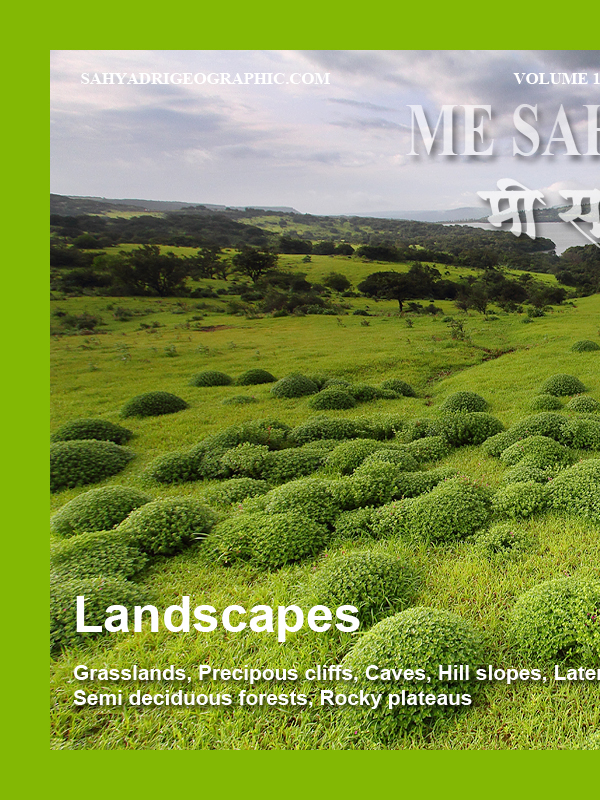 
|
| |
Me Sahyadri - October 2014
Pleocaulus ritchei, Satara district, western ghat, lateritic plateau, India
Visit the Photoessay published in October 2014, by clicking on the image.
|
| |
|
|
The monsoon transformed the land. The small hills were now covered with the green grass. It was as green as it could have been. It was early morning, and the sun was yet to rise. The streamlets were carrying the water downhill. The little barking dear was grazing in the grass close to theforest. The grass was all wet, and the dew drops were all sparkling. The dew was everywhere. The small spider webs were all ornamented with the dew. I wondered, had someone ever seen the dew drops forming. The web was perfect, the dew drops were lit in the twilight. Around the corner, we could see the beautiful
semispherical plants. The group of plants looked as if the tortoises are walking downhill towards the lake.
|
|
The plants had kept the distance from each other. The leaves were places along the spherical surface. It was surprising to note that these plants were more disciplined in their growth,nlike most of the plants and trees which we see show randomness in their growth. Otherwise the symmetry in nature is not surprising. We see it in flowers, leaves and animals These spherical plants are called as Pleocaulus ritchei. The plant flowers once in 7 years. It is endemic to western ghats. One plant had flowered. All kind of insects were on the plants. Small honeybees were hovering on the plant with purple flowers. There were occasional pink flowers stemmed out of the semi sphere of Pleocaulus ritchei. These pink flowers were of Impatiens lawii. We observed the honeybees, the little insects around the flowers for a while.
|
|
|
| |
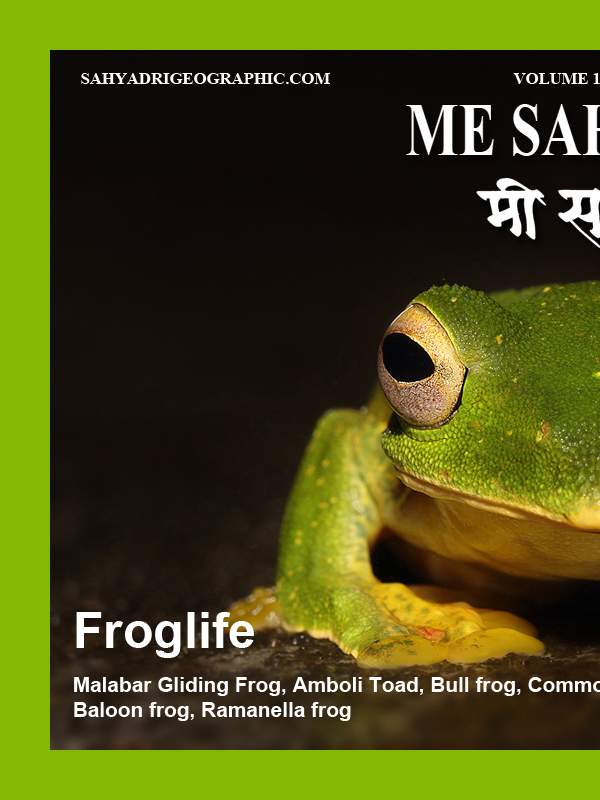 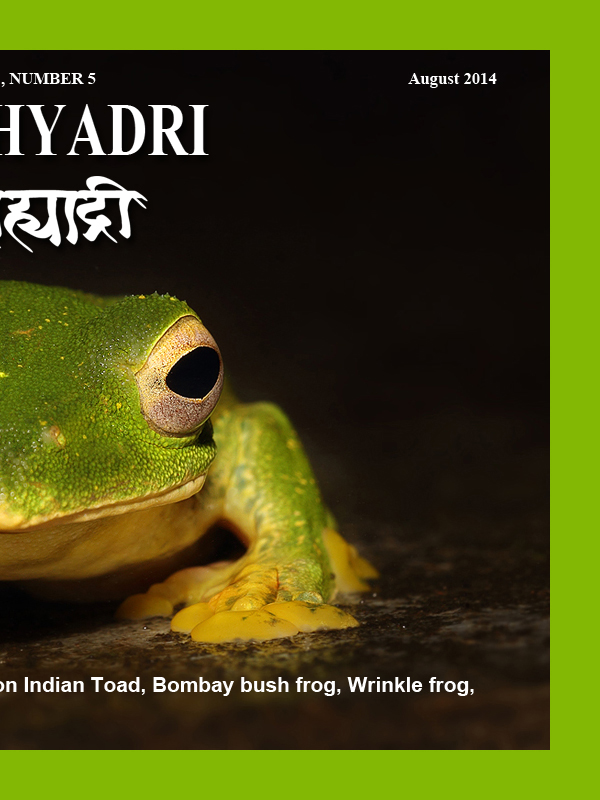
|
| |
Me Sahyadri - August 2014
Malabar gliding frog, Kolhapur district, western ghat, evergreen forest, India
Visit the Photoessay published in August 2014, by clicking on the image.
|
| |
|
|
बेडकांबद्दल महत्वाच्या १० बाबी,
१) बेडुक पाण्याजवळ किंवा पाण्यात रहातात. ते प्रदुषणाचे निर्देशक आहेत. जलप्रदुषणामुळे बेडुकांची संख्या कमी होते आहे. शेतात वापरल्या जाणाऱ्या किटकनाशकांमुळे व इतर रसायनांमुळे जलप्रदुषण होते.
२) बेडकांचे लहान अधिवास मोठया जंगलाच्या अधिवासाचे लहान भाग असतात. झाडे, तलाव, डबकी, झुडुपे, झरे व ओढे, दगड धोंडे असे विविध अधिवास विविध बेडकांना आश्रय देतात. या सर्व घटकांचे संवर्धन म्हणजेच बेडकांचे संवर्धन होय.
३) पश्चिम घाटात दिसणारे बहुतांश बेडुक अंतर्जन्य आहेत. त्यांचा अधिवास पश्चिम घाटापुरता मर्यादीत आहे. पश्चिम घाटाचे संवर्धन म्हणजे त्यांचे संवर्धन होय.
४) जलप्रदुषण, शेतकी प्रगती, बुरशी रोगराई, अधिवासाचा विनाश अशा कारणांमुळे बेडुक कमी होत आहेत.
५)बेडुक हा खाद्यश्रुंखलेतला महत्वाचा घटक आहे. लहान किडे, डास यांना खाद्य करुन तो त्यांच्या संख्येवत नियंत्रण ठेवतो.
६) बेडुक पावसाळ्या व्यतिरिक्त काळात सुप्त (हायबरनेट) होतात.
७) बेडुक पावसाळ्यात अंडी टाकतात.
८) सह्याद्रीत आढळणाऱ्या बेडकांमध्ये बरेच बेडुक संकटात आहेत. आय यु सि एन संस्थेच्या वर्गिकरणाप्रमाणे या बेडकांना वाचवण्याचे प्रयत्न झाले पाहिजेत.
९) वाघ, सिंहांवर जेवढे पैसे खर्च केले जात आहेत, त्यामानाने बेडकासारख्या लहान पण तितक्याच मह्त्वाच्या प्राण्यांकडे सर्वच दुर्लक्ष करत आहेत.
१०) पश्चिम घाटात सध्या काही नविन बेडकांचे शोध लागले आहेत. बऱ्याच जातींवर संशोधन चालु आहे.
|
|
10 important aspects about frog are
1) Frogs are indicators of water pollution. The population of frogs is reducing due to water pollution. Water pollution takes place due to use of pesticides and other chemicals.
2) Frogs live in microhabitats within the larger forest habitat. These microhabitats can be streams, rocks, trees, bush, puddles, soil, low foliage. Conservation of every such element within the larger forest habitat is important.
3) Western ghats has many endemic species of frogs. Conservation of western ghats is important for survival of these species.
4) Water pollution, agricultural development, tourism, fungal infections, loss of habitat are the main reasons of reduction in numbers of frogs.
5) Frog is important part of food chain. They feed on insects, mosquitoes.
6) Frogs hibernate most of the time in year during non monsoon period.
7) Most of the frogs in western ghats breed in Monsoon.
8) Many species of frogs in western ghat appear as Threatened as per IUCN red list. The species are protected as per Indian Wildlife act.
9) Govt is spending funds on tigers and lions but not on frogs.
10) Many species of frogs in western ghats are being discovered. The research on the frogs is under progress by various research organizations.
|
|
|
| |
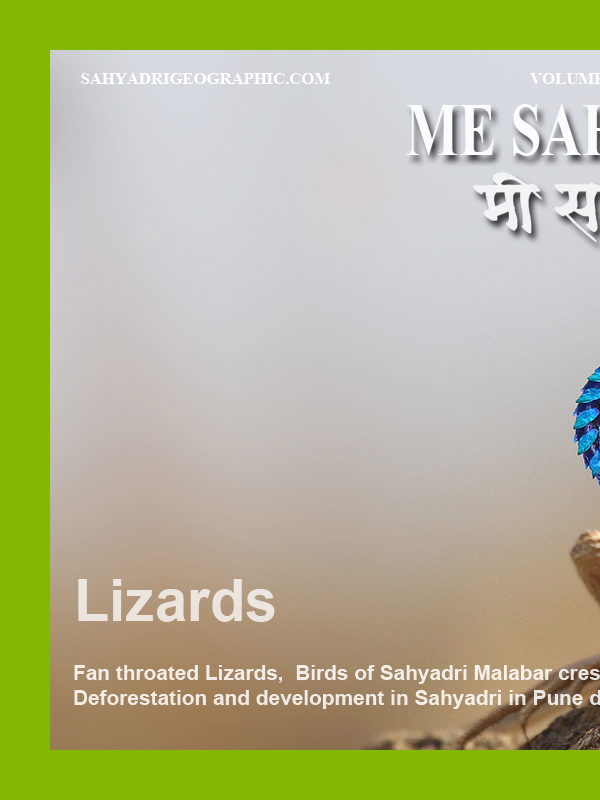 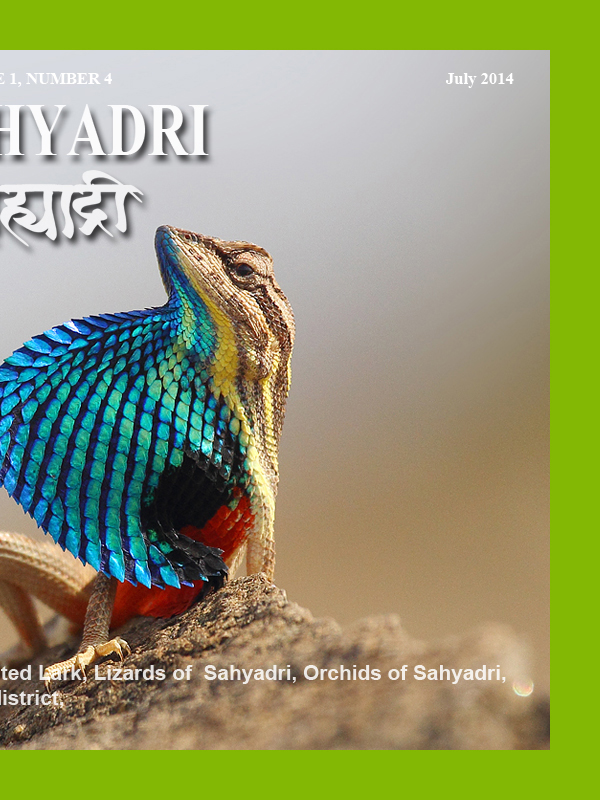
|
| |
Me Sahyadri - July 2014
Sitana ponticeriana, fan throated lizard, Pune district, western ghat, dry region, India
Visit the Photoessay published in July 2014, by clicking on the image.
|
| |
|
|
आपल्या गृहावर एकूण ६००० जातींचे सरडे आहेत. य अशा पाय असलेल्या सरपटणाऱ्या प्राण्यांत सरडे, पाली, सापसुरळ्या हे विविध प्रकार आहेत. तर मोठया सरपटणाऱ्या प्राण्यांमध्ये साप, कासव, मगरी यांची गणना होते. भारतात अंदाजे ५९ जातींचे सरडे, ७९ जातींच्या पाली, ५६ जातींच्या सापसुरळ्या आढळतात. दक्खन्च्या पठारावरचा निळा पडदा असलेला सरडा, हा एक अजब सरडा आहे.
|
|
On our planet there are 6000 species of Lizards. The small reptiles with legs can be roughly be classified as Lizards and Agamas, Geckos, skinks. The large reptiles include snakes, shieldtails, crocodiles, and turtles. India has about 79 species of Geckos, 59 species of lizards, 56 species of skinks. Out of 59 species of lizards found in India, “Fan throated Lizard”, also called as
Sitana ponticeriana is singular for its display and behavior.
|
|
|
| |
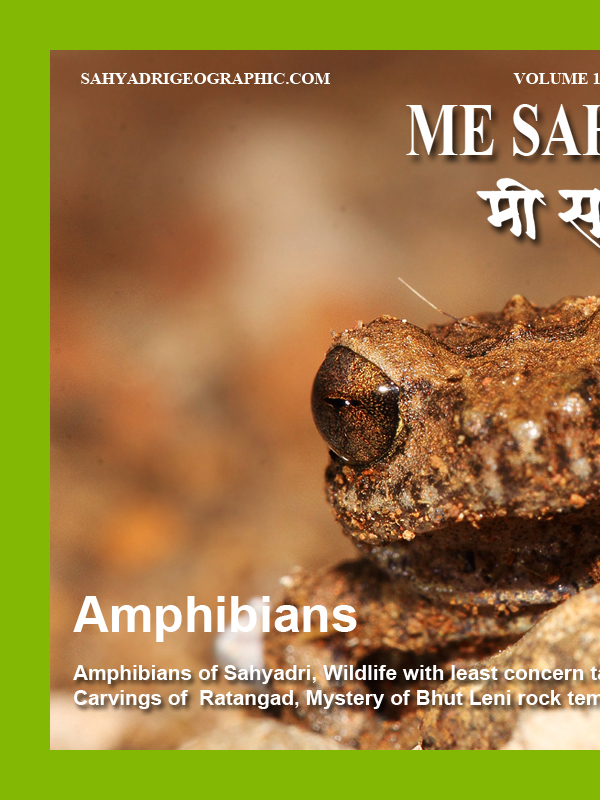 
|
| |
Me Sahyadri - June 2014
Raorchestes species (Bush Frog), Chandoli national park, Satara district, Western ghats, Maharashtra, India
Visit the Photoessay published in June 2014, by clicking on the image.
|
| |
|
|
चला तर समजुन घेऊयात सह्याद्रीतील बेडकांबद्दल, आपला मित्र निनाद गोसावीच्या शब्दांत.
"सह्याद्रीतील जंगले, एक अद्वितीय जैववैविध्यतेचे विश्व आहे. सह्याद्रीमध्ये बेडकांच्या अजब व गुढ जाती आहेत. भारतात आढळणाऱ्या ५० % पेक्षा जास्त जाती सह्याद्रीत आढळतात. येथील बेडकांवर शास्त्रज्ञ संशोधन करत आहेत. बऱ्याच बेडकांबद्दल अजुन संशोधन झालेले नाही. बेडुक अजब प्राणी आहे. तो जमिनीवर, पाण्यात, झाडांवर सुद्धा आढळतो. तो सॄष्टीतील खाद्यशृंखलेतला अत्यंत महत्वाचा घटक प्राणी आहे. ते मोठया प्रमाणात किडे खातात. यामुळे किड़्यांवर नियंत्रण रहाते. कोकणात बेडुक ओरडायला लागला कि पाऊस येणार असा समज आहे. पाऊस झाल्यावर डबक्यांच्या अवतीभवती त्यांचे डराव डुक सुरु होते. एकाच वेळी बरेच बेडुक ओरडु लागले कि त्याला एक वाद्यवृंदाचे रुप येते. शास्त्रज्ञ बेडकांच्या आवाजांचा अभ्यास करत आहेत. वेगवेगळ्या जातींमध्ये मादी वेगवेगळ्या ठिकाणी अंडी घालते. काही पाण्यात, काही जमिनीवर दगडाखाली, काही पानांवर, अंडी घालतात. पण बरेच बेडुक लुप्त होण्याचा धोका वाढत आहे. याला अनेक कारणे आहेत. अधिवास, पाण्याची डबकी, दलदल, पाणथळ जागा, गवताळ प्रदेश, जंगले नष्ट होत आहेत. बेडुक त्याच्या आजुबाजुस होणाऱ्या बदलांमुळे प्रभावीत होतो. विविध प्रकारच्या बुरशींमुळे बेडकांना धोका निर्माण झाला आहे. बरेच बेडुक आपल्याला अचंभित करतात. ते सुंदर असतात. आपल्याला त्यांच्या बद्दल फार कमी माहिती आहे. आपण बेडुक लुप्त होऊन देऊ नयेत."
|
|
Let us understand what the Sahyadri frogs mean from Amphibian enthusiast Ninad Gosavi,
"Sahyadri , a land of forest , rich in biodiversity. This land has , mysterious variety of frogs. More than 50% species of frog of India are found in Sahyadri hill range. Lots of frogs are still unknown and scientists are working on it. Frogs are the super animals, they can live on land , under water and some species live on trees also. Frogs are one of the important stage in food chain. They eat pest of cultivation and help to control it. Their call is said to be the indicator of rain in most of the villages of Konkan.
After first rain of monsoon , some of them gather around small pond and start music concert with their unique call. Scientists are now working on documentation of these calls in western ghats. After breeding , female lay eggs according to habit of species. Some deposit eggs in water , some on land under rocks , some deposit on large leaves and some make nest by folding leaf.
But now a days we are loosing these beautiful creatures . Lots of reasons are behind it. Loss of habitat is one of the main threat faced by frogs. Loss of water ponds , marshes , grass lands , forest causes vanishing of these little life. Frogs are very sensitive to their environment , they show change in their body according to the vital changes in their niche. Dermal fungal infection on frogs is also affecting on the population of frogs in Sahyadri.
Frogs are beautiful , amazing. We know very little about it. Sahyadri has lots of unknown frogs. We should not loose them. "
|
|
|
| |
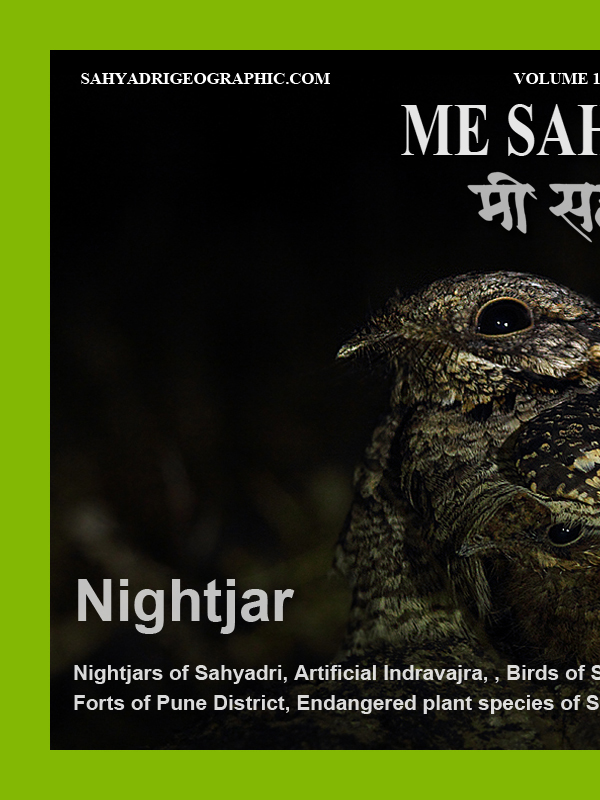 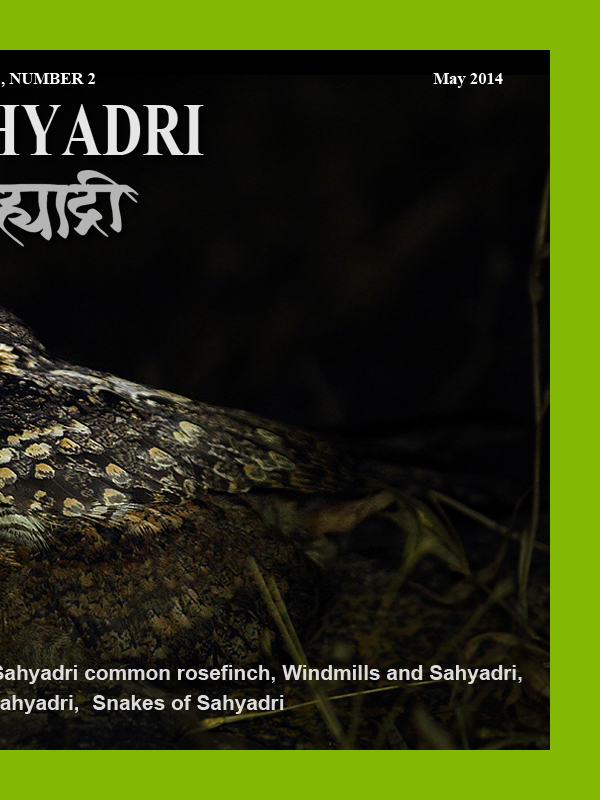
|
| |
Me Sahyadri - May 2014
Indian Nightjar, Chandoli national park, Satara district, Western ghats, Maharashtra, India
Visit the Photoessay published in May 2014, by clicking on the image.
|
| |
|
|
शहरीकरणामुळे लुप्त झालेल्या बरेच पशु व पक्षी शहरी माणसाला माहित नसतात. याचे एक उदाहरण म्हणजे रातवा हा निशाचर पक्षी. रात्री हा पक्षी सक्रिय असतो. रातवा दिवसा आराम करतो. रातवा छोटे पतंग, किडे खातो. त्याच्या अंगावर ठिपके व रेघांचे अदभुत डिझाइन असते. त्यामुळे तो जमिनिवर बसलेला असताना किंवा झाडावर बसला असताना पटकन ओळखु येत नाही. त्याचे रंगरुप झाडाच्या सालीत व पालापाचोळ्यात लपते. यामुळे या पक्ष्यांना, दिवसा आराम करणे सोपे होते. रात्री हे पक्षी बऱ्याचदा जमिनीवर बसलेले दिसतात. आपल्या पृथ्वीवर रातव्यांच्या ८० जाती आहेत. त्यांचे रहाणीमान एक्सारखे असले तरी, रंगरुप, आकार, अधिवास यात फरक आहे. भारतात ९ जातीचे रातवे आढळतात. त्यात प्रामुख्याने भारतीय रातवा, करडा जंगल रातवा, सव्हाना रातवा, जेर्डॉन रातवा, इजिप्शियन रातवा, युरेशियन रातवा, मोठया कानांचा रातवा, साइक्स रातवा, मोठया शेपटाचा रातवा असे प्रकार आहेत. या ९ जातींपैकी ५ जातींचे रातवे सह्याद्री परिसरात आढळतात. (भारतीय रातवा, जंगल करडा रातवा, जेर्डॉन रातवा, सव्हाना रातवा व मोठया कानांचा रातवा). यातले कोणतेच रातवे जरी सह्याद्रीचे अंतर्जन्य नसले तरी त्यांचा पर्यावरणाच्या सृष्टीशृंखलेत महत्वाचे स्थान आहे. भारतीय रातवा आकारने लहान असतो, त्याच्या पखांवर तपकिरी ठिपके असतात. मोकळ्या माळावर व डोंगरांच्या पायथ्याला तो आढळतो. रातव्याच्या रात्री च्या संचारामुळे घुबडांसारख्याच त्यांच्या बाबतीत बऱ्याच गैरसमजुती व अंधश्रद्धा आहेत.
|
|
Most of the urban people are not aware of the wildlife, particularly the one which is lost due to urbanization. One such bird is Nightjar.
Nightjars are the nocturnal birds. They are active in the night and take rest in the day time. These birds feed on moths and insects in the night or during early morning. They are very well camouflaged. The camouflage is like dried leaves or tree bark. This helps these birds to remain undetected during the day time when these birds take rest. These birds are seen roosting on the rocks or on the ground during night. There are about 80 species of nightjars on our planet. They vary in their shape, size, plumage and habitat. There are nine species of nightjars seen in India. These include, Indian nightjar, Large-tailed nightjar, Grey nightjar, Syke’s nightjar, Savana nightjar, Jerdon’s nightjar, Great eared nightjar, Eurasian nightjar, Egyptian nightjar. Out of these nine species, about 5 species, namely Indian nightjar, Savana nightjar, Grey nightjar, Jerdon’s nightjar, Great eared nightjar are seen in western ghats. Though none of these birds are endemic, they play a vital nocturnal role in the forest clearings and open country habitats in western ghats. Indian nightjar (Caprimulgus asiaticus) is a widespread resident nightjar, It is a small but brightly streaked and dotted with brown patterns. It is seen in open country and at the foothills. Nightjars are often heard in the night than they are seen. Due to nocturnal nature of these birds many superstitions are associated with the bird all across the world.
|
|
|
| |
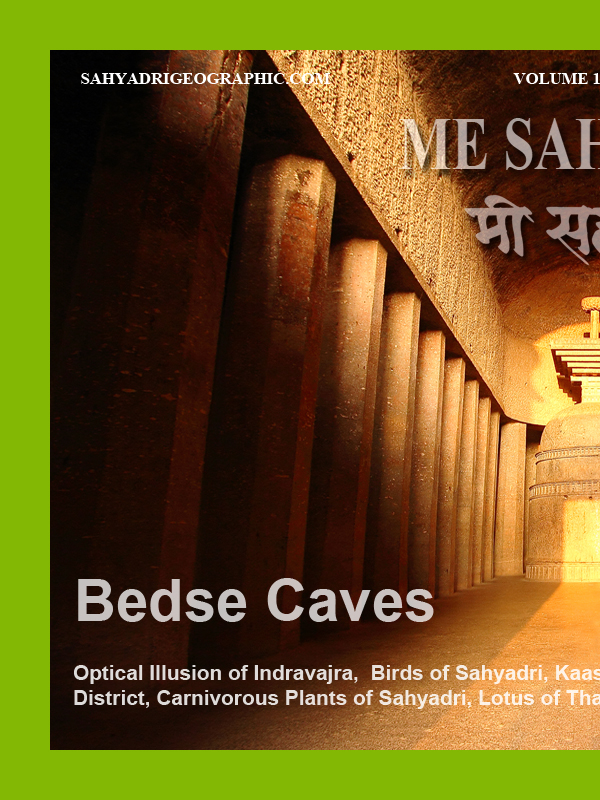 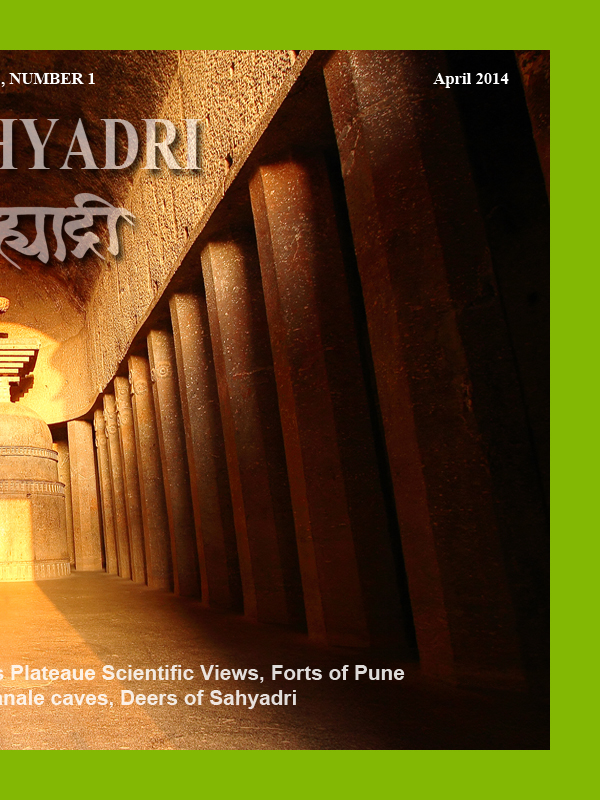
|
| |
Me Sahyadri - April 2014
Divine light, Chaitya griha, Bedse Cave, Western ghats, Maharashtra, India
Visit the Photoessay published in April 2014, by clicking on the image.
|
| |
|
|
सुंदर सुर्यप्रकाशाने न्हावुन सकाळ तयार झाली होती. तिरप्या सुर्यप्रकाशात तेजस्वी लाल फुलांनी नटलेल्या सावराच्या वृक्षांनी डोंगर प्रफुल्लित झाला होता.
रात्रभर साठवुन ठेवलेला बोचरा गारवा पाषाणी रमला होता.
सोनचाफ्याचे जमिनीवर पडलेले फुल अजुन ही आपला सुगंध सोडत नव्हते.चैत्यगृहाच्या दारातुन व त्या वरच्या खिडकीतुन तांबुस मंद प्रकाश आत आला.
हवेतल्या हलत्या धुक्यामुळे तो मंद प्रकाश मेणबत्तीच्या प्रकाशासारखा बिचकत होता.
दुर क्षितिजावर डोंगरामागुन सुर्य झरझर वर सरत होता. त्याचा लाल रंग पिवळा सोनेरी झाला तसा चैत्यगृहात सोनेरी उजेड पसरला. स्तुपाच्या मागील पटलावर चैत्यगृहाच्या बाहेरचे स्तंभावरचे कलश आपली ओळख देऊ लागले. स्तुपावरचे लाकडी फुल जणु उमलले.
सुर्याच्या सोनेरी रथाचे पडघम मनात ऐकु येऊ लागले. रविंद्रनाथ टागोरांनी लिहिलेल्या कवितेतल्या विचारांची अनुभुती मिळाली. अनुभुती मिळण्यासाठी मला बरीच धडपड करावी लागली. हे छायाचित्र काढण्यासाठी, एकुण पन्नास एक तास खर्च करावे लागले. बंगळुरच्या श्रीहर्षा ने केलेले मार्गदर्शन, टागोरांच्या कवितेतुन मिळालेले स्फुरण, उपयोगी ठरले. दहिभाते काकांनी जिवापाड जपलेली लेणी आणी मिळालेल्या एकुण अनुभुती बद्दल; आपण सविस्तर लेखात जाणुन घ्या.
|
|
Oh Sunlit Morning,
wash me with the Light rays of yours
Oh the beautiful sunlit morning,
wash me with the springing light rays of yours and
remove the dust which has covered my true self,
Oh the beautiful sunlit morning,
wash me with the beautiful light rays of yours and
The one within me who is still entangled within the net of sleep,
you gently touch his forehead with your golden wand and wake him up.
Today wash me with these rays of joy, coming from the vast universe,
so as to wash away all narrowness and darkness from every corner of my mind.
Within the veena of my heart is sleeping the song of immortality,
which has neither words, nor rythum or notes; touch the innermost chord with this awakening of joy in this morning.
- Rabindranath Tagore
Visit the Photoessay published in April 2014, by clicking on the image
|
|
|
| |
![]() |
| |
|
|
| |
|
|
| |
|
References :
Contact me at kale_v@rediffmail.com for any queries and suggestions.
|
|